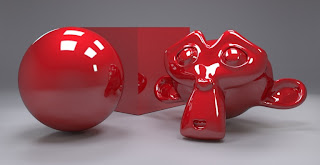Now I'm going to introduce a light modification in the node before to create a basic carpaint material like these:
In the coated glossy node, explained in the plastic material, I have changed the diffuse node by a glossy node with GGX type.
This produce a wide range of red colors below the reflections. I have inserted a new parameter called ShinyMultiplier. It is the rougnness of the new glossy node. It should be 0.2 or higher. I was looking for a kind of ramp diffuse node for one color. The parameters for the images above are as follows:
The color of the coating is not random. I have chosen the complementary of the base color. This is the reason of the node group name.
Bye
























